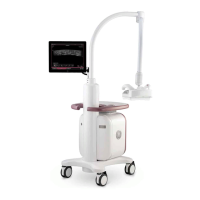Diagnostics/Troubleshooting
7-34 Invenia ABUS 2.0 – System Setup and Basic Service Manual
4700-0043-00 Rev. 4
Different Power
Outlet
Connect the unit to another power outlet and verify if the noise
changes or disappear.
NOTE: Invenia ABUS 2.0 requires a dedicated power and ground for
the proper operation of its Ultrasound equipment. This dedicated
power shall originate at the last distribution panel before the
Ultrasound system.
The Invenia ABUS 2.0 will function on voltages from 100-240
Volts and 50 or 60 Hz. However, if using 220 volt power in North
America, then a center tapped power source is required.
Sites with a mains power system with defined Neutral and Live
:
The dedicated line shall consist of one phase, a neutral (not
shared with any other circuit), and a full size ground wire from
the distribution panel to the Ultrasound outlet.
Sites with a mains power system without a defined Neutral
:
The dedicated line shall consist of one phase (two lines), not
shared with any other circuit, and a full size ground wire from the
distribution panel to the Ultrasound outlet.
Different system Try another Invenia ABUS 2.0 at the same location and look for
the same noise. If the noise is present on the new system too,
the noise is most likely from an external source/equipment.
Different location Move the Scan Head Assembly to another location and verify if
the noise changes or disappear. This may help you to locate an
external noise source.
Try to move the Scan Head Assembly to:
• another location inside the room
• another room
• another floor
Disconnect
external cables
Disconnect network cable to verify if the noise disappears.
Overview of types
of noise
There are different types of noise. Use the information next to
classify the noise and possible cause.
Noise picked up
from the air
Electromagnetic Interference (EMI) from radio frequencies,
magnetic fields, and transients in the air.
If picked up by a transducer cable, the noise will be coherent
-“penlight noise” pointing down in the picture - due to the fact
that the noise is received on all channels.
• Is it a problem on the transducer?
Remove transducer, reverse (flip it), and replace transducer.
• Is it a problem on one of the transducer connectors only?

